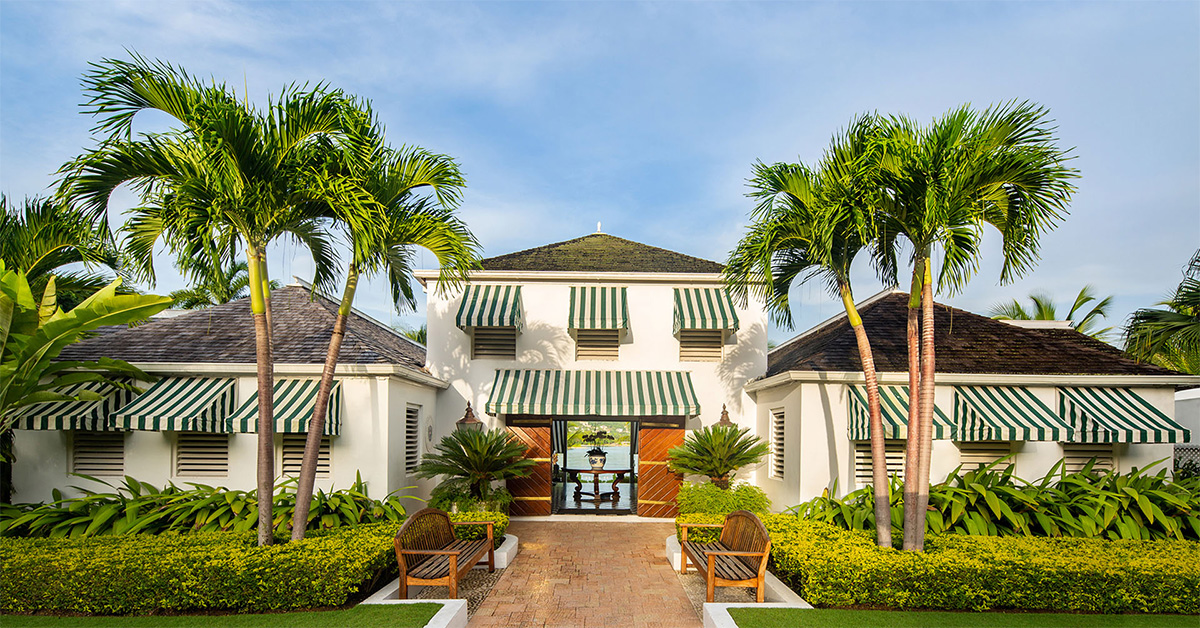Valencia is World Design Capital for 2022. Laura French shows us how to spend a weekend in the Spanish city
Click here to download and save as a PDF
Winding alleys lined with candy-coloured houses, intriguing museums that tell stories from the past millennium, sandy beaches lapped by swathes of blue – Valencia fuses the best of city life with a chilled beachy vibe, then adds awe‑inspiring architecture and exceptional cuisine into the mix for good measure.
This year, the city has been named World Design Capital, meaning there’s never been a better time to sell a short break to this good-looking, design-conscious destination. So we’ve put together a two-day guide to its best architectural, historical and culinary spots to help inspire you and your clients.
Day one
10.00: Kick off your trip with a slice of Valencian history on a visit to the Unesco-listed Silk Exchange, or Lonja de la Seda. Built in the 15th century, this Gothic, castle‑like masterpiece was once a trading point on the Silk Road, bringing merchants flocking from across Europe to purchase silk brought over from Asia.
Visitors can explore its courtyards and halls – adorned with intricate bas‑relief ceilings, gold-gilt beams and twisted stone pillars – and learn about Valencia’s Golden Age and how the silk trade helped turn the city into one of the most prosperous in Europe.
Learn about Valencia’s Golden Age and how the silk trade helped turn the city
13.00: Pay a visit to Valencia’s heart and soul: the Mercado Central. This sprawling covered market – about the size of a football pitch – is one of the biggest of its kind in Europe, offering cured meats, local cheeses, seafood, wines, pastries and more. The building is impressive too – think sloped iron-beamed ceilings, colourful tilework and a huge patterned dome recalling its art nouveau beginnings in 1928.
Especially unmissable is the Central Bar, covered in shimmering black tiles and designed by Barcelona‑based Francesc Rifé. Also try Uno, a gourmet food stand sporting hand-painted tiles by local designer Jaime Hayon.
15.00: Continue your cultural ambles with a visit to Valencia Cathedral, a 13th-century masterpiece that dominates the Old Town with its gothic bell tower. Inside, it’s just as impressive, with an elaborate altar set beneath a bright-blue frescoed ceiling, and an intriguing museum showcasing artefacts from the city.
Don’t miss the Borja Chapel, home to paintings by Goya and other artists, and the Capilla del Santo Cáliz, whose gold, glass-encased Roman chalice is said to be the Holy Grail.
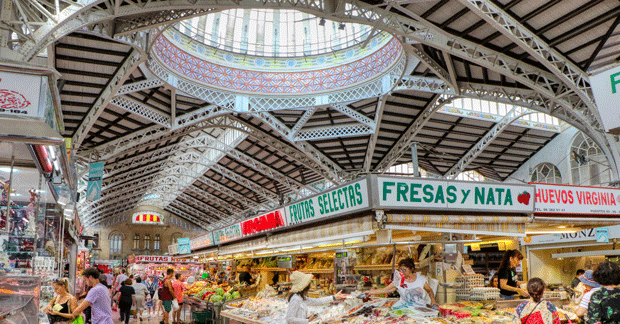
17.00: A three-minute stroll from the cathedral will take you to another of the city’s most striking buildings, he Palacio del Marqués de Dos Aguas, an opulent baroque palace bedecked with intricate sculptures.
Built in the 15th century, and renovated in the 18th century, it now houses the National Museum of Ceramics and Decorative Arts, a collection of ceramics and other items donated to the state by collector Manuel González Martí in the 1950s and displayed amid sparkling chandeliers and palatial halls.
Don’t leave without trying the Manchego cheese, patatas bravas and Valencian tomatoes
20.00: Valencia isn’t short on impressive dining spots, but for an authentic experience head to Colon Market, a covered food market that turns into a favourite drinking spot come evening, with restaurants and bars luring locals to its art nouveau surrounds. You’ll find some of the best tapas in the city at Bar Mi Cub: don’t leave without trying the Manchego cheese, patatas bravas and Valencian tomatoes, all fresh from the market.
22.00: Bed down at SH Inglés Hotel. Set just opposite the Palacio del Marqués de Dos Aguas, this four-star boutique is perfectly located for exploring Valencia’s Old Town, with the cathedral, Mercado Central and Silk Exchange all within a five‑minute walk. The hotel is housed in a renovated 18th‑century mansion with a sleek design and contemporary rooms. Rooms cost from £103 per night (excluding breakfast).
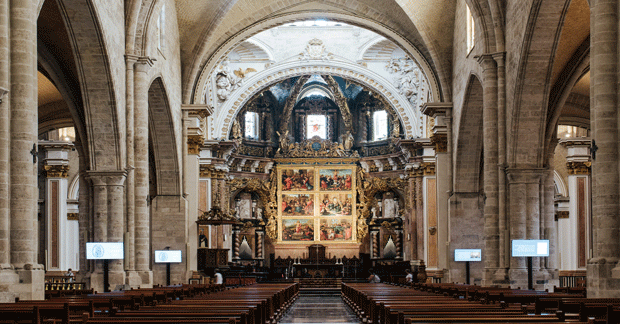
Day two
10.00: Head to the coast this morning to see another side of Valencia. There are several beaches in and around the city, but for one of the best try Playa de Las Arenas, a wide, gold-sand stretch lapped by calm water and lined with a boardwalk promenade.
While you’re here, venture into the surrounding El Cabanyal neighbourhood to see streets of colourful houses and intricate patterned tilework, and stop by the Cabanyal Market for fish hauled in that morning.
13.00: Wander over to the marina for lunch. Marina Beach Club has earnt itself something of a reputation for its place-to-be-seen vibes, but for a less busy alternative try El Camarote, a rooftop bar and restaurant serving salads, seafood and paellas to a backdrop of blue. Opt for the Valencian paella with chicken, rabbit and artichokes to stick with tradition, or try the toasted red tuna for a fresh catch.
Wander the botanical garden to see flora from across Spain and beyond
15.00: Head back inland to see the City of Arts and Sciences, one of Valencia’s architectural gems and most iconic design spots. Set above a series of pools and lakes, and in various eclectic shapes, this series of contemporary buildings by Spanish architect Santiago Calatrava houses a science museum, 3D cinema and opera house centre among its attractions, as well as the biggest aquarium in Europe.
Wander the botanical garden to see flora from across Spain and beyond, or rent a rowing boat to glimpse these striking silhouettes from a different angle.
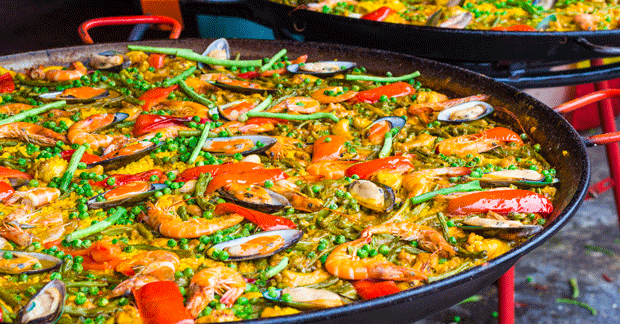
17.00: Amble back towards the Old Town via the Jardin del Turia, a huge park set on the site of a former riverbed (the river was diverted in the 1950s to prevent flooding). Today, its series of 18 bridges remain, each designed in distinct forms by various architects; don’t miss the 15th‑century Trinidad bridge, then check out the contemporary Puente de la Exposición, designed by Calatrava several centuries later.
19.00: Now check out some of the city’s striking street art. Valencia’s historic El Carmen neighbourhood is awash with colourful designs, but for some of the best examples head to Calle Moret (also known as Calle de las Colores).
Here you’ll find murals created by renowned street artists to revive a once‑rundown alleyway. A particularly popular mural, El Beso (The Kiss), is a favourite Instagram spot for couples – complete with the hashtag #kissmevlc.
Valencia’s historic El Carmen neighbourhood is awash with colourful designs
20.00: When hunger strikes, head for Vaqueta Gastro Mercat. Opened in 2019, this modern-style restaurant takes nature as inspiration, with tables nestled among plants, bamboo sticks screening private tables and large lights hanging above rustic brick walls.
The menu focuses on seasonal ingredients, much of it sourced from the Mercado Central next door, with fresh seafood, Iberian pancetta and Valencian paella among the standouts; don’t miss the helado de horchata (ice cream), made with Valencia’s famous tiger nut milk, then wash it down with a glass of wine from a Valencian bodega to toast a memorable end to your trip.
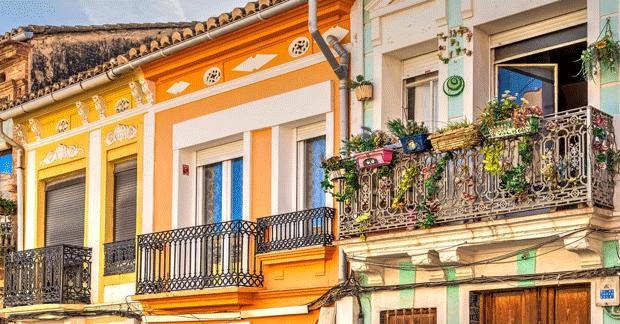
Ask the expert
Eva Fernandez, international PR and marketing executive, Visit Valencia

“Valencia has 2,000 years of history, with generations of designers having left their creative mark. The distinction of World Design Capital 2022 is a recognition of this and a big opportunity to showcase how design can be a tool to improve quality of life. Valencia has developed a full programme of activities for the celebrations. There are more than 100 events including exhibitions, conferences and festivals such as the World Design Street Festival (September 19‑25).
“Visitors can find out more when they arrive at the Agora Valencia. Located in the iconic Plaza del Ayuntamiento, this is a temporary building showcasing the design‑related events for the year. We’re excited to welcome visitors back for the year ahead and beyond, and we’re already seeing figures as high as pre‑pandemic for this summer. Bookings for the winter season are also looking strong, and airlines have added almost half a million seats, meaning we have nearly 25% more air capacity than we had in our best year.”
Book it
Osprey Holidays offers two nights’ B&B in a Standard Double at the SH Hotel Ingles from £399, based on flights from Gatwick on October 3.
ospreyholidays.com
PICTURES: davidrota.com; Shutterstock/Massimo Todaro, Negnut, Stefano Politi Markovina; David Rota
Read more
Why Barcelona should be next on your list for science-themed attractions
48 hours in Madrid, Spain
Five of the best things to do in Benalmadena, Spain

